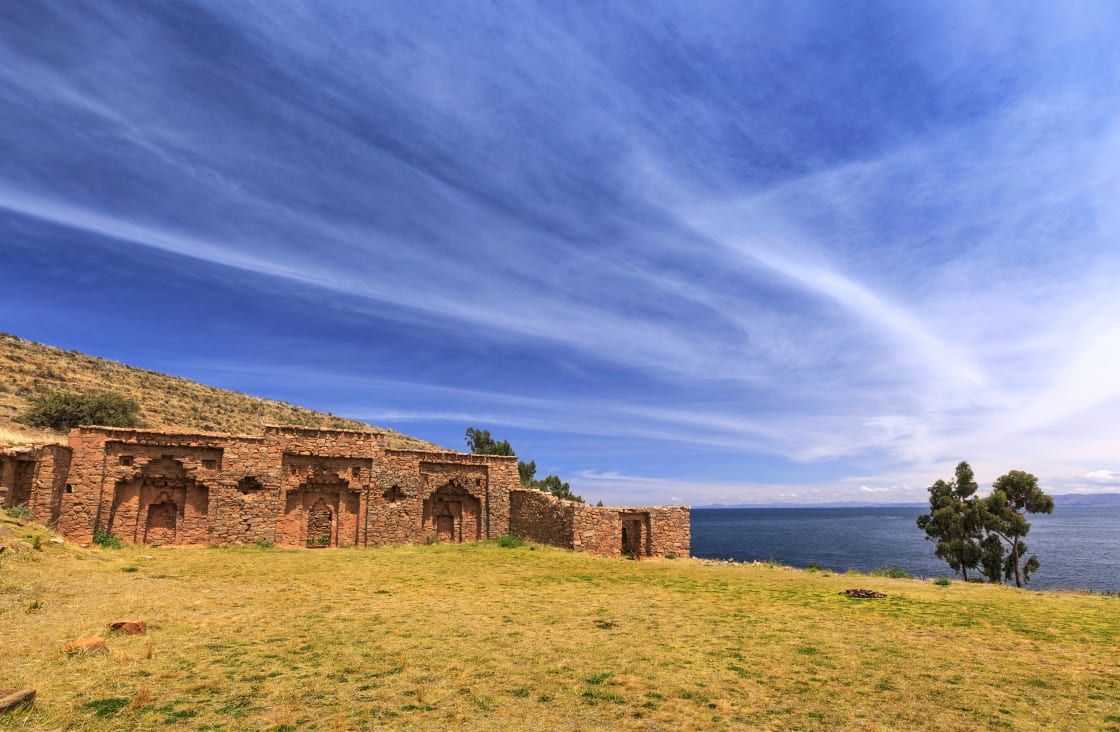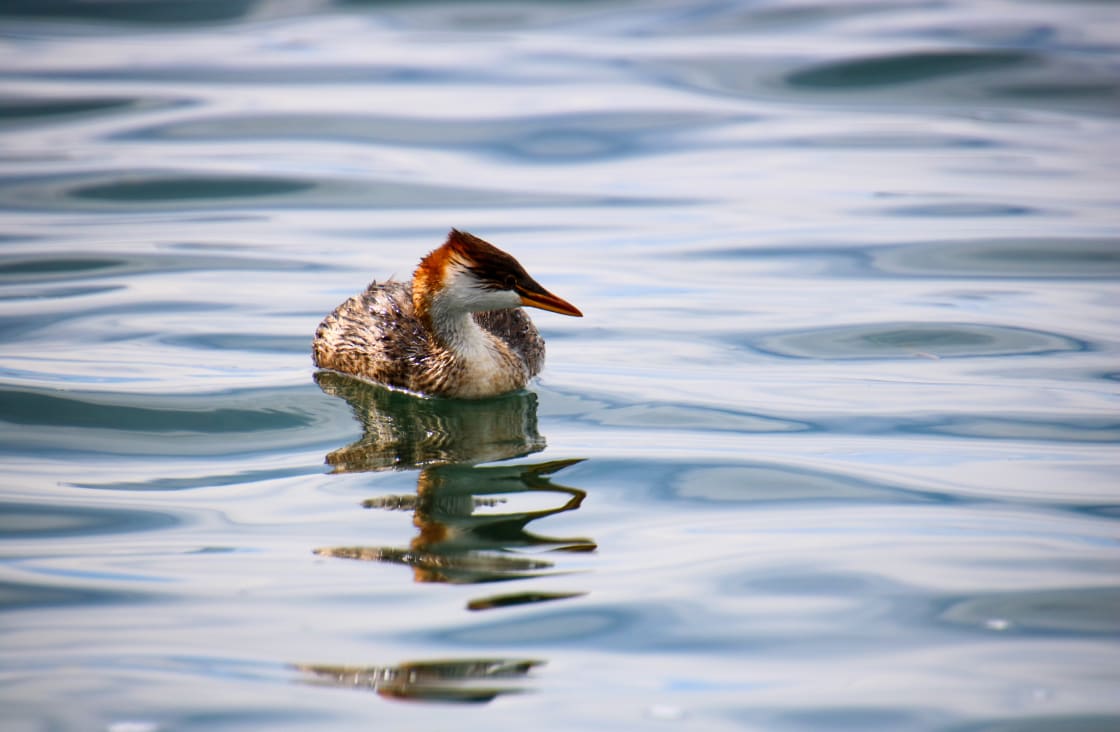
You’ll quickly recognize Lake Titicaca from the mesmerizing photos: deep blue skies mimicking the rich blue color of the waters below, fringed by yellow grass reeds that are used to construct the traditional boats and homes floating upon it, graced by locals all adorned in brightly-colored traditional attire.
If the photos aren’t enough to inspire you to visit, we’ve compiled our 10 favorite interesting facts about Lake Titicaca in South America to help convey what makes the nature, history, people and culture of this remarkable body of water such a unique destination to add to your itinerary.
Local communities believe that the shape of the lake depicts that of a puma hunting the rabbit. Thus the name, Titicaca, comes from the word “Titi Khar’ka” meaning Rock of the Puma in Aymara (a local indigenous language).
Lake Titicaca is called “The Birthplace of the Incas”, and “The Birthplace of the Sun”. Incan mythology says that the first Inca king, Manco Capac, was born at Lake Titicaca. The Gods later created a wife for him and they began a tribe that later blossomed into the Inca Empire, making Lake Titicaca “The Birthplace of the Incas.” An ancient Incan myth also tells the story of the God Viracocha coming out of the lake and creating the sun, the stars, and the first people.
The highest navigable body of water in the world, Lake Titicaca sits 3,800 meters above sea level. At 12,500 feet above sea level in the Andes Mountains of South America, it sits astride the border between Peru to the west and Bolivia to the east. For those concerned about the altitude, it may be worth noting Titicaca is higher than Cusco (11,152 feet) but lower than the highest point on the Inca Trail (13,780 feet).
Over forty islands are sprinkled throughout Lake Titicaca, hosting a mix of rolling hills, various populations and ancient ruins begging to be explored. A majority of them are inhabited, the largest of which is the Isla del Sol (Island of the Sun) on the Bolivian side. On this one island alone you will find over 180 ancient Incan ruins. The other major islands are Amantani, Taquile (Peru), Isla de la Luna, Suriki (Bolivia). Also on the Peruvian side are the famous artificial floating islands of the Uros people, which are made of totora reeds.
In addition to Inca ruins found on the islands and shore of Lake Titicaca, a temple structure was recently found at the bottom of the lake. In the area surrounding the great body of water there are more than 180 ruins of ancient monuments that belonged to the civilizations that once lived in the region. Not far from the lake is Tiwanaku, the “Stonehenge of the Americas”, a UNESCO World Heritage Site.
Lake Titicaca is protected by Peruvian law (national reserve status). It was also designated as a Ramsar Site in 1998. Lake Titicaca is currently one of seven Peruvian sites waiting on UNESCO’s Tentative List; if approved, it will become one of the official UNESCO World Heritage Sites in Peru.

Island of the Moon, Lake Titicaca
The highest point on the lake is on Isla del Sol at 13,400 feet above sea level. It is the largest of all the islands (5.5 x 3.75 miles) and used to be regarded as the home of the supreme Inca sun god Inti. The town of Challapampa on the north end of the Island of the Sun is home to the intriguing Chinkana labyrinth, possibly a training center for Inca priests. The sacred rock near the labyrinth is carved in the shape of a puma. It was used for rituals and sacrifices. Nearby is the Isla de la Luna, home to the ruins of a convent for virgin priestesses. Both islands are on the Bolivian side of the lake.

Grebe Swimming In Lake Titicaca
The ecology of Lake Titicaca may not get as much attention as that of the neighboring Amazon rainforest but certainly deserves recognition. More than 530 aquatic species can be found in Lake Titicaca, as well as many species of water birds. Threatened species than can be found here include the enormous Titicaca water frog and the Titicaca grebe. Approximately 90% of the fish found in the basin are endemic species not found anywhere else.
More than 25 rivers and many glaciers empty into Lake Titicaca, but only one drains from it. This river is the Desaguadero, and it only drains 5% of incoming water (the other 95% is lost through evaporation).

Chinkana Archaeological site of Tiwanaku, Sun Island, Lake Titicaca
Before the Inca civilization, three other peoples resided at Lake Titicaca and left their marks on the culture: the Pukara, Tiwanaku, and Collas.

Aerial Top View of Floating Islands, Lake Titicaca
The Uros people, descendants of a much more ancient culture, continue to live on Lake Titicaca on floating islands. These islands, along with their homes and boats, are made entirely of reeds that grow along the shore of the water. Their economy relies upon tourism and fishing.
The immense body of water creates a warmer and more humid microclimate than you’d think, amazingly making the cultivation of potatoes and quinoa possible at this altitude, and sustaining the population of the surrounding area of approximately 228,000 people. Locals also keep herds of alpacas, llamas, sheep, and cows.
While Rainforest Cruises aim to provide accurate and up-to-date information, we make no representations as to the accuracy or completeness of any information herein or found by following any link on this site. Rainforest Cruises cannot and will not accept responsibility for any omissions or inaccuracies, or for any consequences arising therefrom, including any losses, injuries, or damages resulting from the display or use of this information.




